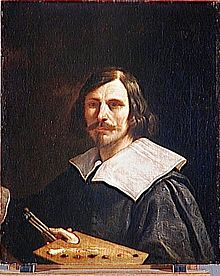Guercino
Guercino | |
|---|---|
 Self portrait, c. 1635 | |
| Born | Giovanni Francesco Barbieri February 8, 1591 |
| Died | December 22, 1666 (aged 75) |
| Nationality | Italian |
| Known for | Painting |
| Movement | Baroque |
Giovanni Francesco Barbieri (February 8, 1591 – December 22, 1666), best known as Guercino or Il Guercino, was an Italian Baroque painter and draftsman from the region of Emilia, and active in Rome and Bologna. The vigorous naturalism of his early manner is in contrast to the classical equilibrium of his later works. His many drawings are noted for their luminosity and lively style.
Biography

He was born at Cento, a village between Bologna and Ferrara. At an early age he acquired the nickname Guercino (Italian for 'squinter') because he was cross-eyed.[1] Mainly self-taught, he was apprenticed at the age of 16 to Benedetto Gennari, a painter of the Bolognese School.[2] By 1615 he had moved to Bologna, where his work gained the praise of an elder Ludovico Carracci. Guercino painted two large canvases, Elijah Fed by Ravens and Samson Seized by Philistines, in what appears to be a stark naturalist Caravaggesque style (although it is unlikely he had been able to see any of the Roman Caravaggios first-hand). They were painted for Cardinal Serra, Papal Legate to Ferrara.
The Arcadian Shepherds (Et in Arcadia ego) was painted in 1618 contemporary with The Flaying of Marsyas by Apollo in Palazzo Pitti. Its dramatic composition is typical of Guercino's early works, which are often tumultuous.[3] His first style, he often claimed, was influenced by a canvas of Annibale Carracci in Cento. Some of his later pieces approach rather to the manner of his contemporary Guido Reni, and are painted with more lightness and clearness.
He was recommended by Marchese Enzo Bentivoglio to the Bolognese Ludovisi Pope, Pope Gregory XV. The two years he spent in Rome, 1621–23, were very productive. From this period came his frescoes of Aurora at the casino of the Villa Ludovisi and the ceiling in San Crisogono (1622) of San Chrysogonus in Glory; his portrait of Pope Gregory (now in the Getty Museum, and, what is considered his masterpiece, The Burial of Saint Petronilla or St. Petronilla Altarpiece, for the Vatican (now in the Museo Capitolini).

After the death of Gregory XV, Guercino returned to his hometown. In 1626 he began his frescoes in the Duomo of Piacenza. The details of his career after 1629 are well documented in the account book, the Libro dei conti, that Guercino and his brother, Paolo Antonio Barbieri, kept and which has been preserved.[4] In 1642, following the death of Guido Reni in Bologna, Guercino moved his busy workshop to that city and become its principal painter. The Franciscan order of Reggio in 1655 paid him 300 ducats for the altarpiece of Saint Luke Displaying a Painting of the Madonna and Child (now in Nelson-Atkins Museum of Art, Kansas City). The Corsini also paid him 300 ducats for the Flagellation of Christ painted in 1657.
He was remarkable for the extreme rapidity of his execution—he completed no fewer than 106 large altar-pieces for churches, and his other paintings amount to about 144. He was a prolific draftsman who made many drawings, usually in ink, ink with wash, or red chalk. Most were made as preparatory studies for his paintings, but for his own enjoyment he also drew landscapes, genre subjects, and caricatures. His drawings are noted for their fluent style in which "rapid, calligraphic pen strokes combined with dots, dashes, and parallel hatching lines describe the forms".[5] Guercino continued to paint and teach up to the time of his death in 1666, amassing a notable fortune. As he never married, his estate passed to his nephews, Benedetto Gennari II and Cesare Gennari.[1]
Notes
References
- Herbermann, Charles, ed. (1913). . Catholic Encyclopedia. New York: Robert Appleton Company.
- Marchese Antonio Bolognini Amorini (1843). "Parte Quinta". Vite de Pittori ed Artifici Bolognesi. Tipografia Governativa alla Volpe, Bologna. pp. 223–272.
- Griswold, William M. (Spring 1991). "Guercino". Metropolitan Museum of Art Bulletin. 48(4): 5–56.
Gallery
-
Susanna and the Elders, 1617
-
St. Francis with an Angel Playing Violin, 1620
-
Aurora, 1621
-
Crucifixion of Christ with Madonna and Saints Mary Magdalene, St. John and Saint Prosper at his feet, 1624–25
-
Mary Madgalene, ca 1624-1625, Blanton Museum of Art, Texas
-
The Death of Dido, 1625, Palazzo Spada, Rome
-
Semiramis receives the news of Insurrection at Babylon, 1645
-
Joseph and Potiphar's Wife, 1649, National Gallery of Art
-
St. Luke Displaying a Painting of the Virgin, 1652–53
-
Personification of Astrology, ca. 1650–55, Blanton Museum of Art, Texas
-
St. Thomas writing the Holy Sacrament, 1662
-
David with the Head of Goliath














